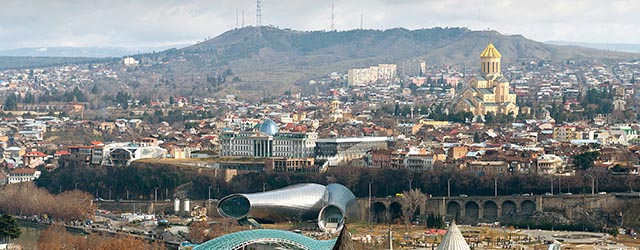Azerbaijan, Georgia and Armenia are not masters of their own economic destinies, with events in Russia and the rest of the region casting a shadow over these countries’ efforts to boost economic and investor confidence.

The countries of the southern Caucasus are no strangers to uncertainty or crisis: Their location, sandwiched between a revanchist Russia to the north and Iran to the south, is virtually a guarantee against an easy life. However, even by local standards, the past few months have been pretty tough, more than confirming last October’s IMF forecast for the region that external shocks will continue to weaken growth prospects and heighten financial vulnerabilities.
“After a few years of relative calm and some economic progress, the region finds itself at the mercy of a deteriorating geopolitical environment and falling growth,” says Simon Quijano-Evans, head of emerging markets research at Commerzbank. “This has impacted on already-fragile investor confidence.”
Azerbaijan, Armenia and Georgia have all been hit by the latest geopolitical bomb—the growth in tensions between two of the three regional powers, Russia and Turkey. Russia’s economic crisis—reinforced by the collapse in energy prices and continuing Western sanctions following Moscow’s incursion into eastern Ukraine—has hit exports and led to a major drop in remittances, a problem that is particularly serious for Armenia, but also Georgia. Meanwhile, the slowing of Turkey’s economy has impacted on Georgia and Azerbaijan, both important trading partners with that country.
All three economies have also been impacted by fast-growing private, corporate and, in some cases, government debt, with rising nonperforming loans (NPLs) putting pressure on already-fragile and undercapitalized banking systems; Azerbaijan’s credit rating was downgraded to junk by S&P at the end of January. All three have experienced major currency devaluations, with the strength of the dollar reinforcing this; meanwhile, growing dollarization is storing up more problems for the future. Political risk is rising even after elections in Azerbaijan (January saw demonstrations at falling living standards) and ahead of the rather freer parliamentary elections scheduled for October in Georgia. Opinion polls suggest indecision between the incumbent party, Georgia Dream, and its anti-Russian predecessor, Mikheil Saakashvili’s former party, the United National Movement.
“Policymakers are doing what they can, but the sheer volume of risk in this region will continue to dampen business confidence,” says Neil MacFarlane, associate research fellow in the Russia-Eurasia program at London analyst firm Chatham House.
LIFE IS HARD
Of the three countries, perhaps Azerbaijan’s economy has had the hardest fall, owing to the dramatic drop in the price of oil and the country’s dependence on it. Oil accounted for 39% of GDP and 95% of exports in 2014, but fell to 31% of GDP and 86% of exports last year. Full-year GDP figures for last year will almost certainly show growth close to zero, well below what was forecast during the year. This year’s budget was predicated on oil at $50 a barrel before it was announced in January that the new assumption was $30 per barrel.
Two big devaluations of the Azerbaijani manat last year—33% in February, after which the central bank reportedly spent half its reserves trying to support its fixed dollar peg before abandoning it in December, leading to a further 48% devaluation against the dollar—have made life hard for individuals and banks. Devaluation led to further dollarization: Some 70% of bank deposits are currently in dollars.
Banks are suffering from the central bank’s currency devaluations and higher capital requirements, which led to six banks closing in January. More consolidation is likely, not least because of new capital controls, along with a new law insuring retail deposits in full. In January, Azerbaijan’s central bank governor, Elman Rustamov, said as many as seven banks could be merged.
“In the short term, Azerbaijan’s economy won’t grow much and inflation will be double digit,” says Paul Gamble, head of emerging Europe sovereigns at Fitch Ratings.
Although there has been talk of diversification, supported by the World Bank, and made more likely by the Azerbaijani government’s improvement to the banking system and business environment, it will take time. Analysts admit that the government’s huge energy investments—two massive new gas projects, Umid, with potential reserves of 200 billion cubic meters, and Absheron, with 350 billion cubic meters—suggest meaningful movement out of energy is unlikely. However, observers see underlying resilience, with central bank reserves and sovereign wealth fund assets estimated to be $42 billion, enough to cover 26 months worth of imports.
“The devalued manat helps with external and fiscal rebalancing and can boost competitiveness of the non-oil sector,” says Dmitri Gvindadze, the European Bank for Reconstruction and Development’s (EBRD) lead economist in Baku. “It is important to use this opportunity to continue simplification of public services, to modernize the banking sector and enhance the level playing field for the private sector.”
THE MOST DIVERSIFIED AND REFORMED

Georgia also had a difficult 2015, with the lari devalued by more than 40% against the dollar, growth slowing amid declining investor confidence and growing uncertainty, and exports dropping by almost 15%. Debt is a growing concern, with external obligations now equal to 100% of GDP and likely to rise (public debt is around 42%) as a consequence of slower growth and rising dollarization. Bank NPLs are also expected to rise.
But the EBRD’s lead economist in central Asia, Agris Preimanis, says context matters. “Georgia has faced a sharp slowdown of regional trading partners, resulting in lower exports and remittances, and it has been affected by negative investor perception spillovers from the Russia/Ukraine crisis.” He adds that Georgia’s growth of 2.8% in 2015 compares favorably to regional peers.
Vakhtang Butskhrikidze, CEO of TBC Bank, likewise sees strength. “The fundamentals of Georgia’s banking sector remain strong, as demonstrated by its resilience over many years. The impact of regional turbulence has been a modest slowing of loan growth in real terms and a modest increase in NPLs. Overall the sector remains growing, profitable, healthy and well capitalized,” he says. A confident TBC, listed on the London Stock Exchange since its June 2014 IPO, expects to move into the premiumlisting segment later this year.
As the most reformed and diversified economy in the Caucasus, Georgia is in a good spot. TBC Bank notes no industry contributes more than 15% of GDP. Turkey has been an active investor, but Georgia needs to attract more foreign direct investment and boost exports. It has made progress, signing a Deep and Comprehensive Free Trade Agreement (DCFTA) with the European Union in June 2014 and working to improve the business climate with greater transparency and fewer regulatory barriers. But policymakers will need to do more.
“One of Tbilisi’s challenges is to find ways of moving towards being a more value-added economy, but this will remain a long-term challenge,” says Alex Muscatelli, director at Fitch Ratings. “Foreign investment and capital inflows are important for financing the high current-account deficit; external finances are a key rating weakness.”
And what of the least-developed economy, Armenia? It has suffered from its close relationship with Russia, on which it depends for trade (some 24% of the total), investment and military support (key in the continuing standoff with richer Azerbaijan over Nagorno Karabakh in the southern Caucasus). It chose Moscow’s Eurasian Economic Union over closer relations with the West and the EU, but hoped-for projects and increased trade haven’t materialized. Trade fell 20%-22% last year with mining and agriculture (globally depressed sectors) its main exports.
“Because Armenia’s economy is small with a narrow export base, much will depend on the ability to retain the strong policy framework under the IMF program,” says the EBRD’s Gvindadze.
However, given regional uncertainty, there are limits to what these three governments can do, as Commerzbank’s Quijano-Evans points out. “We can talk about what must be done to boost growth, confidence or investment,” he says, “but at the end of the day, these countries remain hostage to events in Russia and the wider region.”
|
Caucasus: Main Economic Indicators | |||||
|---|---|---|---|---|---|
|
Country |
GDP growth % 2015 |
GDP growth % 2016* |
FDI stock |
FDI Inflows, |
FDI as % of gross fixed |
|
Azerbaijan |
3 |
2.5 |
18.18 |
4,430 |
25.1 |
|
Armenia |
2.3 |
2 |
5.8 |
383 |
16.8 |
|
Georgia |
2.5 |
2.6 |
12.2 |
1,280 |
35.3 |
|
Sources: UNCTAD and EBRD, *projected | |||||



